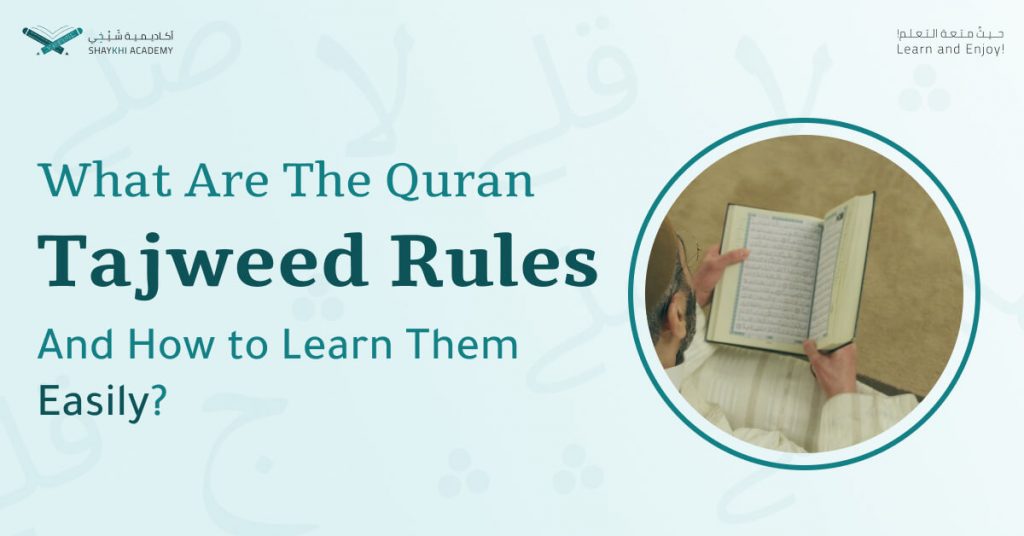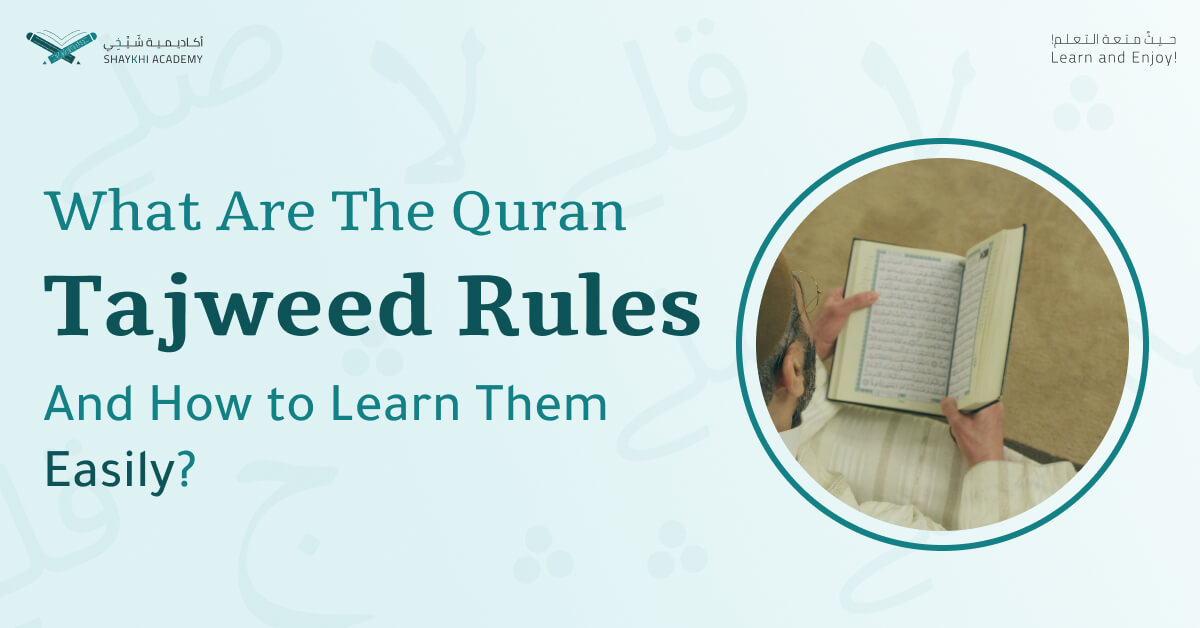
Before telling you what are the Quran Tajweed rules and how to learn them, let’s first know the meaning of Isti’aathah and Basmalah and their rulings
Rullings of Al-Isti’aathah And Al-Basmalah
Isti’aathah
Allah has commanded us to say Al-Isti’aathah before reading the Holy Quran when he the Almighty said in Surah Al-Nahl Ayah 98: {فَإِذا قَرأْتَ الْقُرْآنَ فَاسْتَعِذْ بِاللَّه مِنَ الشَّيْطانِ الرَّجيم}. And Isti’aathah is to say “أعوذ بالله من الشيطان الرجيم” or “A‘oothu billahi min al-shaytaani al-rajeem”. When you say it you’re literally seeking refuge in Allah from Shaitaan the accursed.
Basmalah
Basmalah is to say “بسم الله الرحمن الرحيم” or Bismillahi Al-rahmani Al-raheem. And it is Wajib to be used to separate between the Surahs, except for Surah Al-anfal and Bara’ah.
Now let’s move to the next point and know what is Tajweed and why it is used
What Is Tajweed?
“Tajweed” in the Arabic language means to improve something. And it is one of the Quran sciences that look into how to pronounce the Quranic words correctly as well as everything related to them, and that’s in order to be able to recite the Holy Quran the same way our prophet peace be upon him did.
The History of Tajweed
Tajweed started when Gabriel Alayhi salam read the Quran with Tajweed on our prophet Muhamed peace be upon him, and then the prophet taught it the same way to the sahaba. And that’s how it reached us, by passing it generation to generation.
In the early days of Islam, only the Noble Quran was preserved on paper because the prophet peace be upon him said: “Do not write anything from me; whoever has written anything from me other than the Qur’aan, let him erase it and narrate from me, for there is nothing wrong with that“.
However, when Islam spread and non-Arabs entered it, errors in the Quranic recitation began to appear. As a result, scholars were urged to establish guidelines for this science that would help in correcting the reading. Then, its rules were established and its errors were corrected in accordance with the prophet’s recitation of the revelation Gabriel Alayhi salam gave to him.
But what are those Tajweed rules? let’s find out!
Tajweed Rules
Tajweed is divided into 2 parts, Theoretical and practical. Let’s start with the theoretical part
Theoretical Tajweed
The theoretical is a set of rules that help you improve you recitation which if enough Muslims fulfill it, it falls from the rest, because it is a sufficient duty.
Practical Tajweed
Practical Tajweed is the action of reading The Quran in the right way and it is a must for all Muslims to learn and fulfill.
Now that we learnt about Tajweed and its parts, you must know 2 things in Tajweed; Haq’l harf (The right of the letter) and Mustahaq’l harf (Dues of the letter). As for Haq’l harf it is the letter’s required characteristics that never leave. While Mustahaq’l harf is presented characteristics that sometimes is there and sometimes not there.
Rulings of Noon Sakina And Tanween
There are 4 rulings that must be taken into account when pronouncing noon Sakina or Tanween with other letters, and they’re as follows:
Izhar الإظهار
The Arabic word “Izhar” means to show something or make it visible, and speaking of Tajweed, Izhar means to show Noon Sakinah or Tanween in one of the throat letters that come after noon Sakina and Tanween, and those letters are: (ك , ي , ء, ا, خ, ه, ع, ل, م, ح, ز, غ, ر, س )
Noon Sakina could come with one of Izhar letters in the same word like the word “يَنْهَوْنَ” in the following Ayah: (وَهُمْ يَنْهَوْنَ عَنْهُ وَيَنْأَوْنَ عَنْهُ وَإِن يُهْلِكُونَ إِلَّا أَنفُسَهُمْ وَمَا يَشْعُرُونَ). While Tanween only comes with Izhar letters when they’re in 2 separated words like “مَنْ آمَنَ” in the following Ayah: (قُلْ يَا أَهْلَ الْكِتَابِ لِمَ تَصُدُّونَ عَن سَبِيلِ اللَّـهِ مَنْ آمَنَ تَبْغُونَهَا عِوَجًا)
Idgham الإدغام
The Arabic word “Idgham” means to combine 2 things together, and in Tajweed, it is joining a Sakin (consonant) letter with another that is not Sakin (a vowel) so that they become one single stressed letter. Meaning, to add Noon Sakina or Tanween to one of Idgham letters which are: (ي, ن, و, ل, م, ر)
Idgham is divided into 2 groups, Idgham with ghunna and Idgham with no ghunna. And Ghunna is a sound that goes into the nose when pronouncing certain letters.
Idgham with Ghunna
Its letters are: (ي, ن, م, و). So, if Noon sakina or Tanween comes after one of those letters, you pronounce it with ghunna. Like in the following Ayah when a noon sakina came with the ي in مَن يَعمَل
(وَمَن يَعمَل مِنَ الصّالِحاتِ وَهُوَ مُؤمِنٌ فَلا يَخافُ ظُلمًا وَلا هَضمًا)
Idgham with No Ghunna
Its letters are: (ر, ل),
The rule: if noon sakina or Tanween come after one of those letters, you pronounce it with no ghunna; like in the word مِن لَدُنهُ in the following Ayah: (قَيِّمًا لِيُنذِرَ بَأسًا شَديدًا مِن لَدُنهُ وَيُبَشِّرَ المُؤمِنينَ الَّذينَ يَعمَلونَ الصّالِحاتِ أَنَّ لَهُم أَجرًا حَسَنًا)
Iqlab إقلاب
Iqlab in Arabic means to turn something into something else. However, in Tajweed Iqlab is when u replace a letter with another considering Ghunna of the first letter, it is occurred when noon sakina or Tanween come with an Iqlab letter, which is only the ب and turn the noon into a meem like in the word أَنبَتْنَا in the following Ayah: (وَالْأَرْضَ مَدَدْنَاهَا وَأَلْقَيْنَا فِيهَا رَوَاسِيَ وَأَنبَتْنَا فِيهَا مِن كُلِّ زَوْجٍ بَهِيجٍ)
Ikhfaa إخفاء
Ikhfaa in Arabic is to hide something, and in Tajweed it is hiding the noon or the Gunna Tanween when one of the Ikhfaa letters follows the sakin noon or Tanween. Ikhfaa letters are all the Arabic Alphabets except Izhar, Iqlab and Idgham letters.
Rulings of Meem And Noon Mushaddad
Ghunna is required in meem and noon mushaddad by 2 haraka, and haraka here means the amount of time the ghunna lasts.
Ruling of Meem Sakin (The consonant meem)
Meem sakin is the meem that doesn’t have any sign of the Arabic signs of articulations (Harakat). It comes after all the letters except the madd letters, there are 3 rulings for meem sakin:
Ikhfaa Shafawi (اخفاء شفوي)
Where you have to hide the sakin meem when it is with ب as in the ayah: (إِنَّ الَّذِينَ يَخْشَوْنَ رَبَّهُم بِالْغَيْبِ)ز And its called Shafawi because the sound of the meem and the ba come from the lips.
Idgham Shafawi (ادغام شفوي)
Its when a mem sakin comes at the end of the word followed with a voweled mem, u apply idgham to the first mem with the second so it becomes one mem mushaddad with ghunna like in the ayah (هُوَ الَّذِي خَلَقَ لَكُم مَّا فِي الْأَرْضِ جَمِيعًا)
Izhar Shafawi
And that’s by applying Izhar to a sakin meem when it is with any letter with no ghunna, except for Idgham and Ikhfa letters.
Ruling of Idgham
Idgham Mutamathlain (ادغام المتماثلين)
It is when 2 similar letters come together and you apply Idgham to make it sound like a single letter mushaddad (stressed).
Example: (اذهب بكتابي هذا)
Idgham Mutajanis (ادغام متجانس)
It is when you apply Idgham to 2 similar letters that share the same point of articulation but differ in the characteristic to make them sound like one single letter mushaddad (stressed)
Example: (يا بُنَيَّ اركَب مَعَنا)
The Ruling of Lam Sakinah (اللام الساكنة)
The Ruling of (أل) That Is Added to Nouns to Identify Them
It comes before all the alphabets except for the 3 mad letters. And it has 2 rulings: Izhar and idgham.
As for Izhar, it occurs if there was one of the 14 letters in the following sentence after it: “ابغ حجك وخف عقيمه”. Like in the word ” بالبرِّ”. Meanwhile, Idgham occurs when one of the other 14 letters of the alphabet comes after it.
The Ruling of Lam for Verbs (لام الفعل)
It is the lam that comes in verbs whether it was a past, present, or even jussive. No matter if it was in the middle or the end. And it has 2 rulings; Izhar and Idgham. As for Izhar, it is when any letter except ل and ر come after lam like in: (أَنْزَلْناهُ). And Idgham when ر or ل come after the lam like: (قُلْ رَبِّ)
The Ruling of Lam Al-Ism/noun (لام الاسم)
It is when the lam is a part of the letter/word. and it was mentioned in the Holy Quran in only 2 words; “هل” and “بل”. And they follow Izhar rules when the lam is followed with the rest of the Arabic. And Idgham rules when the lam is followed with ر or ل like in: (بَلْ رَفَعَ).
The Ruling of Lam Al Amr/jussive (لام الامر)
It is a lam that is added to a word, placed before the present verb and it follows Izhar rules like in: (لْيَقْضُوا).
The Rulings of Tafkhem and Tarqeeq (التفخيم والترقيق)
Tafkheem (thickness) and Tarqeeq (thinness) are divided into 2 groups in Tajweed:-
Always Mufakhama (مفخم دائما)
Its letters are: ( خ ,ص ,ض , غ , ط , ق ,ظ )
Muraqaq (مرقق)
All the Arabic letters except ر , ل and أ
There’s also that group that is in between:
Sometimes Muraqaq Sometimes Mufakham
Alif: It is Mufakham when it comes after one of the isti’la letters, other than that it is Muraqaq.
Raa: It is Mufakham if it has a fat-ha or dammah like in the word “رَؤُفٌ” or “تَذَكَّرُ “. And if it was sakin followed with one of isti’laletters like in the following example: (إِنَّ رَبَّكَ لَبِالْمِرْصَادِ)
It is Muraqaq if it has a kasra no matter in the beginning of the word, middle, or last. For example: (قَرِيبٌ الْفَجْرِ)
Rulings of Madd
Madd in the Arabic language means to stretch or extend something, and in Tajweed it is to increase the sound using one of the madd letters which are: (ا, و, ي). They’re all mentioned in this Ayah: (نوحيها إِلَيكَ)
Madd is divided into typical madd (مد عادي) and secondary madd (مد فرعي)
The Typical Madd (مد عادي)
It is enough for it to contain one of madd letters without a hamza or even sukon before it or after, and its sound lasts for like 2 seconds.
Example: (بَلَى إِنَّ رَبَّهُ كَانَ بِهِ بَصِيرً).
Secondary Madd/Madd Far’i (مد فرعي)
Madd far’i Due to Hamza
Madd Badal/Exchange lengthening (مد البدل)
And it is called badal (Exchange) for having to exchange the second hamza to a madd letter in case the first hamza was sakin and the second was not. Duration: 2 seconds
Example: (الَّذِينَ اوْتُواْ الْكِتَابَ لَيَعْلَمُونَ)
Madd Semi Badal (شبه البدل)
This is the madd that comes from the madd letter that’s after the hamz in the middle or the end of the word. Duration: 2 seconds
Example: (بِالْمُؤْمِنِينَ رَؤُوفٌ رَحِيمٌ)
Madd Mutasil/Attached (مد متصل)
It is the madd that’s caused by meeting a madd letter with hamza in one word like in “قروء”, or when hamza is after a madd letter. Duration: 4 and could be 5 seconds.
Madd Munfasil/Not Attached (مد منفصل)
It is the madd that occurs when madd letters come with hamza in 2 different words like: (إنّا أعطيناكَ الكوثَر). Or when the madd letter is at the end of the first word and the hamz is at the beginning of the second word. Duration: 4 or 5 seconds
Note: Stopping at the first word cancels the madd
Madd Far’i Due to Sukon
Madd lazim (Important lengthening)
It is the madd that’s caused by meeting a sakin letter with a madd letter where the mad letter is placed at first. And it lasts for 6 seconds
Madd ‘Arid lil-sukun (Lengthening because of the sukoon from pausing on it)
It is when after the letter of madd, there is sakin caused by a waqf. Its duration is 1, 3 or 5 seconds. It is not considered Madd ‘arid unless there was a pause on the word that has a madd letter before the last letter of the word.
Example: (الرَّحِيمِ)
Makharij Al-Huruf (Letters Exits)
Makharij in Arabic means the place where something exits, in Tajweed, it is the letters’ points of articulations, the place where the letters’ sounds exit. There are 5 Makharij, let’s start with Al-Jawf
Al-Jawf
It is the space between the chest and the throat where the madd letters exit.
The Throat
- The deepest part: ه , ء
- The middle part: ح , ع
- Lowest part: غ, خ
The Tongue
- Deepest part: ق
- Middle of tongue: ج، ش (and ي with no madd)
- Tip of the tongue: ض، ل، ن، ر، ط، د، ت، ص، س، ز، ث، ذ، ظ، ف
The Lips
- The letters that require moving the lips to make the sound: ب، و، م
The Nasal Cavity
It is where the ghunna occurs, its letters are non sakin, tanween, mem sakin and mem not Mushaddad
Sifat al Huruf (Letters’ characteristics)
Sifa in Arabic is whatever gives something a meaning but in Tajweed it is the changes that happen to the letter while pronouncing it
Characteristics That Have Opposite
Hams And Jahr الهمس والجهر
Hams is running the breath when pronouncing the letter as a result of the weakness of the point of articulation. and its letters are: (فحثه شخص فسكت)
Jahr is impromisment of the flow of the breath when pronouncing the letters, and the rest of the other letters are Jahri
Shedda And Leen الشدة واللين
Sheddah is running the sound when pronouncing the letter due to its power to depend on the point of articulation, and its letters are: أجد قط بكت. Leen is the opposite.
Isti’laa And Istinfal الاستعلاء والاستنفال (The Elevation And Lowering)
When pronouncing a letter, the deepest part of the tongue is raised, which causes pressure to be directed to the roof of the mouth. This is Isti’laa
Istinfal is basically dropping or lowering. In Tajweed, it is the absence of pressuring the letter to the roof of the mouth because it wasn’t pronounced with the deepest part of the tongue raised.
It’s letters are: (خ ص، ض، غ، ط، ق، ظ)
Itbaq And Inftah الاطباق ةالانفتاح (The Adhering and the Separating)
Itbaq is when the Itbaq letter’s sound is compressed between the tongue and the roof of the mouth.
They are: ص, ض, ط, ظ
Infitah or separation in English is the absence of compression of the sound of the Infitah letter between the tongue and the roof of the mouth.
Its letters are the rest letters in the Arabic alphabet except: ص , ض , ط, ظ
Izlaq And Ismat (الاذلاق و الاصمات)
Izlaq is the easiness in exiting the letter from its point of articulation and that’s because it exits from the tongue or the lips. The opposite of Izlaq is Ismat
Characteristics That Have No Opposite
Safir صفير
In the Arabic language, Safir means: whistling. This is the whistle that accompanies the letters: ص , ز , س
Technically speaking, it’s an extra sound that comes from the lips. The “whistling letters” are another name for these letters.
Example: (عمَّ يتسألون)
Qalqala قلقلة
In the Arabic language, Qalqala means restlessness, instability, disturbance.
It is a powerful effect brought on by the pronunciation of a Sakin letter and because of the quick separation of two pronunciation organs without any mouth opening, curving of the lips, or lowering of the lower jaw. These letters are: ق , ط , ب , ج , د
Qalqala is divided into kubra/كبرى (big) and sughra/صغرى (small):-
Kubra is when a qalqala letter comes at the end of the word like in (قَرِيبٌ)
Sughra is when the qalqala letter is sakin in the middle of the word like in (يَطْمَعُونَ)
Leen
Leen is exiting the letter easily, and its letters are: و and when the ي is sakin and whats before it is fat-ha Example: (خَوْفٌ)
Inhiraf
In the Arabic language, Inhiraf means deviation. This is the deflection of the sound of the letters from their original point of articulation. This concerns the 2 letters: ل and ر
Tafashi
It is when the air in the mouth spread when pronouncing letter ش
Example: (اشتروا الضلالة)
Istitala
In the Arabic language, al istitala means elongation. This is the lengthening of the sound when pronouncing the letter: ض
Saktat (Cuts) Rulings
It means silence but in Tajweed it is cutting the sound on the last word without breathing for like 2 seconds, in Hafs reading it lasts for 4 seconds
Example: The word عوجاً in the following Ayah: (الحَمدُ لِلَّـهِ الَّذي أَنزَلَ عَلى عَبدِهِ الكِتابَ وَلَم يَجعَل لَهُ عِوَجًا )
How to Learn Tajweed Rules with Us?
Shaykhi Academy is the best online academy for teaching the Tajweed rules to both kids and adults. We provide you with teachers specialized in teaching the Quran online and its sciences.
If you want to join us, here are our simple steps:-
Fill Out The Registration Form
Filling out the registration form will allow us to know your name, age, gender, and other more details. If you’re ready, click here.
Attend Our Trial Class
We at Shaykhi Academy offer you a free trial class so you can experience our actual classes before deciding whether or not to subscribe.
Choose Your Plan
Once you’ve decided to subscribe, it’s time to choose the plan that best suits your needs and fits into your schedule.
Subscribe
And finally, subscribe and become a member of our family!
Resourses:
التجويد
أحكام التجويد كاملة
FAQ
(Q&A of Tajweed Rules!)
What is Tawassut in Tajweed?

The letters that are in the middle of Shiddah and Rikhaawah.




















